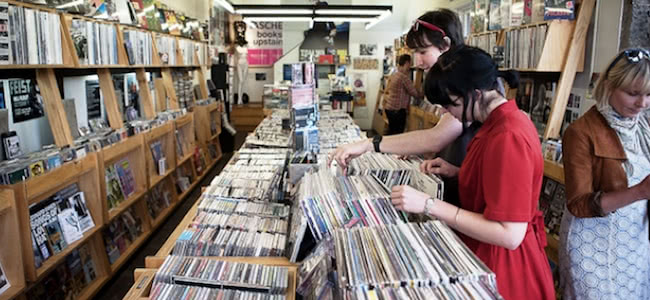Think it’s only your parents who buy records on vinyl? Think again. Coinciding with Record Day 2013 tomorrow (Saturday 20th April), a new report shows that young people are the ones driving demand for vinyl.
The new UK study, by market research company ICM reveals that 18-24 year olds are the biggest buyers of vinyl compared with other age groups.
As reported by Music News, out of all the participants of the study, only 5% had bought music on vinyl in the last month. However, of the 18-24 year old demographic, a significant 14% had purchased vinyl in the last month compared to just 9% for 25-34 year olds and 5% of 35-44 year olds.
The study also revealed that those who bought vinyl also purchased music in other forms, with 52% buying CDs, 31% mp3 downloads, 36% special editions or box sets and surprisingly 19% buying music on cassette tapes, perhaps suggesting another rise in nostalgic formats (especially after Sony killed off its Walkman lines and MiniDisc players).
As for the appeal of vinyl, respondents commented on varying reasons for their love of music on wax. One commented on the quality of vinyl’s sound: “I love the way vinyl sounds so raw. Other formats sound like an annoying frequency if listened to repeatedly, whereas I feel vinyl has a much fuller organic sound,” they enthused. “Also I think the sleeve and artwork on some records are just amazing and nice to have as a collection.” Of the 18-24 year old demographic, a significant 14% had purchased vinyl in the last month compared to just 9% for 25-34 year olds and 5% of 35-44 year olds.
Interestingly these comments reflect the study’s findings that demonstrate that over a quarter of vinyl buyers do not even play their records, but treat them as artistic works. “You can own what is essentially a piece of art in a size where artwork can be appreciated (unlike most CD covers),” one participant said of their appreciation for the physical aesthetic of the format.
The research also revealed that the majority of people buying vinyl purchase their records from second hand or from independent record stores, rather than from first-hand retailers, while a third noted that, regardless of purchasing vinyl or not, preferred to purchase from local and independent stores.
With 86% of vinyl buyers stating they have a nearby record store, the study suggests that having a music shop in close proximity increases the chance of music buyers purchasing vinyl.
“I like the excitement of going to a store and roaming through all sorts of weird and wonderful records I’ve never seen,” said another participant. “I only really buy online if there is something specific I’m looking for and can’t find in shops.”
Britain’s independent music stores are currently seeing a growth in sales after suffering a steady decline since the 1980s that coalesces with the rise of digital music, including the UK recently reaching a landmark 1 billion downloads (with Gotye’s ‘Somebody That I Used To Know’ named as one of the most popular digital downloads of all time).
ICM research director Maurice Fyles spoke of the increasing demand for record stores given the closure of music retail giant HMV in the UK: “Independent record stores are driving and fulfilling a growing demand for music on vinyl – from new limited editions to second-hand collectibles,” he said of the results.
“With the closure of many branches of HMV, some might expect that demand for music shops and physical formats are declining – our research rejects this,” Fyles concludes. “I like the excitement of going to a store and roaming through all sorts of weird and wonderful records I’ve never seen,” said another participant
As previously reported, HMV announced earlier this year that they would be selling their remaining 116 stores to a new investor, the new arriving after they closed 100 stores in the UK, cutting 1,500 jobs as they struggled with debt as sales of physical music declined.
The trends of the ICM study can also be seen in Australia, with CD and physical sales still making up a considerable market share of music purchases despite the rise of new technology such as digital downloads and music streaming services. As previously reported, physical music sales still make up over half, 53.7% of the market’s revenue, according to a report from ARIA.
Speaking of the dominance of physical sales in Australia, ARIA CEO Dan Rosen previously remarked that the results “shows Australian music fans like the tangible experience of still going to the local record store.”
Meanwhile in America, the latest report from the RIAA shows that while physical sales of CDs have continued to decline, from $3.4 billion in 2011 to $2.8 billion in 2012, vinyl has maintained its share of music sales. Vinyl sales continued to experience growth in 2012, with a reported $163 million in 2012, up 36% from the previous year.
While vinyl only accounts for 2% of the market, this is equal to the combined revenue of “ringtones, ringbacks, and other mobile products,” according to the RIAA report.
The study also revealed that those who bought vinyl also purchased music in other forms, with 52% buying CDs, 31% mp3 downloads, 36% special editions or box sets and surprisingly 19% buying music on cassette tapes, perhaps suggesting another rise of nostalgic forms of music.
The new is timely considering tomorrow, Saturday 20th April, is Record Stored Day, where independent music stores around the world come together to celebrate music on vinyl, while musicians are also getting in on the act. Including an unlikely – but awesome – collaboration between Moby and Mark Lanegan, while closer to home Gotye teamed up with musical comedy group Perfect Tripod to record an a capella cover of an Aussie classic.
You can view the full list of Record Store Day 2013 exclusives here or download a handy downloadable .pdf file, and be sure to check out Tone Deaf’s Guide To Record Store Day 2013 below, a comprehensive list of the special performances, deals, and releases that record stores across the country are holding to celebrate.

































